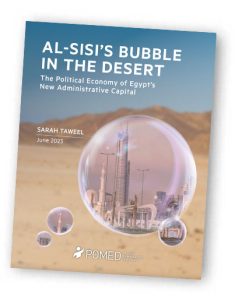 Ten years after Egyptian autocrat Abdel Fattah al-Sisi seized power in a military coup, promising to bring “stability and prosperity,” his debt-fueled spending frenzy on military-led megaprojects has contributed to Egypt’s worst economic crisis in decades. Most prominent among these massive vanity projects is al-Sisi’s $58 billion new administrative capital (NAC).
Ten years after Egyptian autocrat Abdel Fattah al-Sisi seized power in a military coup, promising to bring “stability and prosperity,” his debt-fueled spending frenzy on military-led megaprojects has contributed to Egypt’s worst economic crisis in decades. Most prominent among these massive vanity projects is al-Sisi’s $58 billion new administrative capital (NAC).
A major new POMED report, “Al-Sisi’s Bubble in the Desert: The Political Economy of Egypt’s New Administrative Capital,” draws on extensive research and interviews with industry insiders to provide the first deep dive into who is paying for and who is profiting from the NAC.
The report details how, despite al-Sisi’s repeated insistence that “the state won’t pay a penny” for the new capital, most of the funds have indeed come from the public coffers—even as the president continues to order citizens to tighten their belts and the state struggles to meet its crushing debt obligations. It also documents how billions of dollars have been redirected to the military and regime cronies, tapped to build the NAC through no-bid contracts.
“What we find is an expanding state within a state, with resources funneled to the military regime and debt piled on to the civilian government,” the author writes. “But the NAC and its sister megaprojects are actually making al-Sisi’s hold on power more, rather than less, tenuous—creating bubbles in the desert, ready to pop.”
Read the report here.
Read the report summary and policy recommendations here.
Sarah Taweel, PhD, is a pseudonym for a researcher specialized in Middle East politics. Due to the sensitivity of the issues in this report, POMED has chosen to protect the author’s identity.





